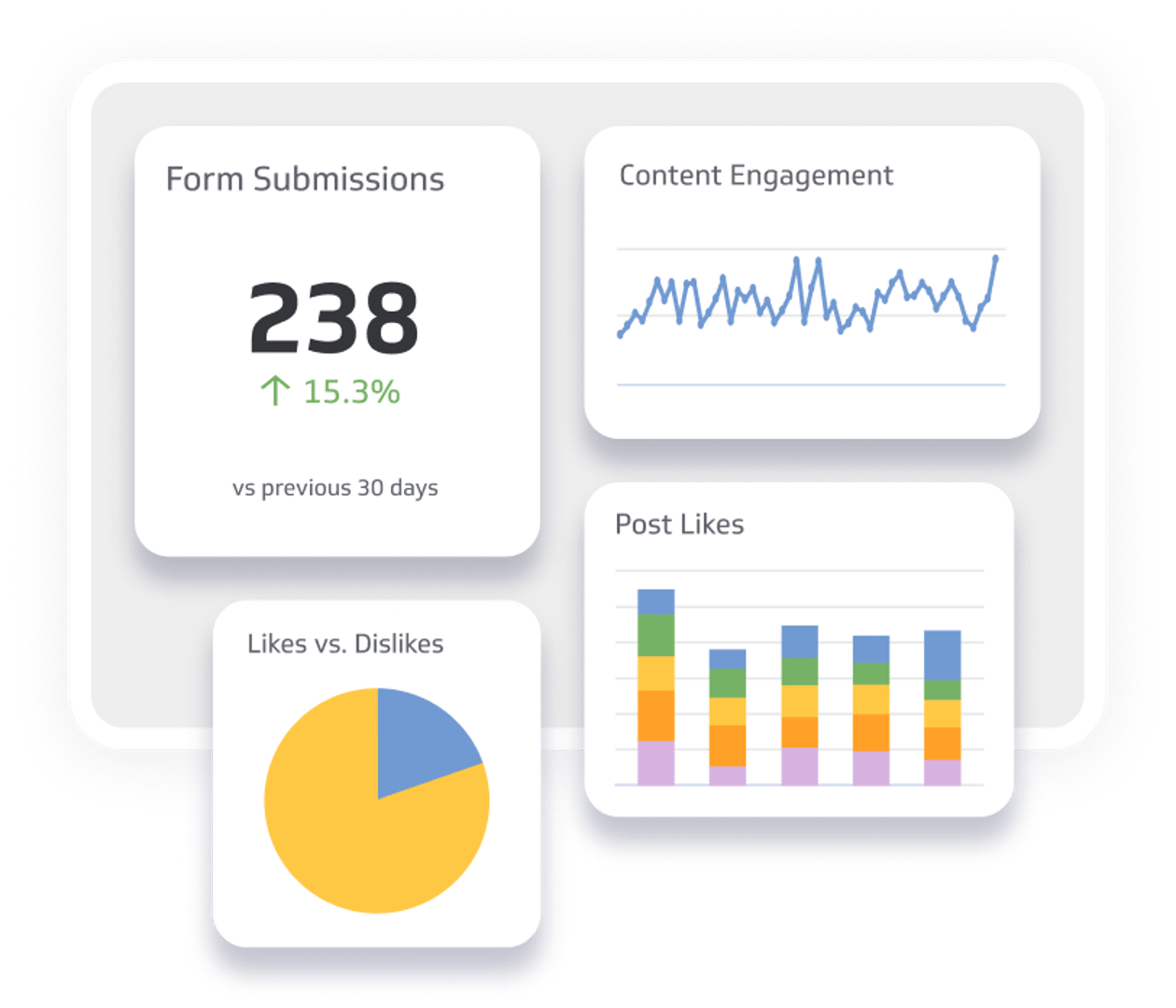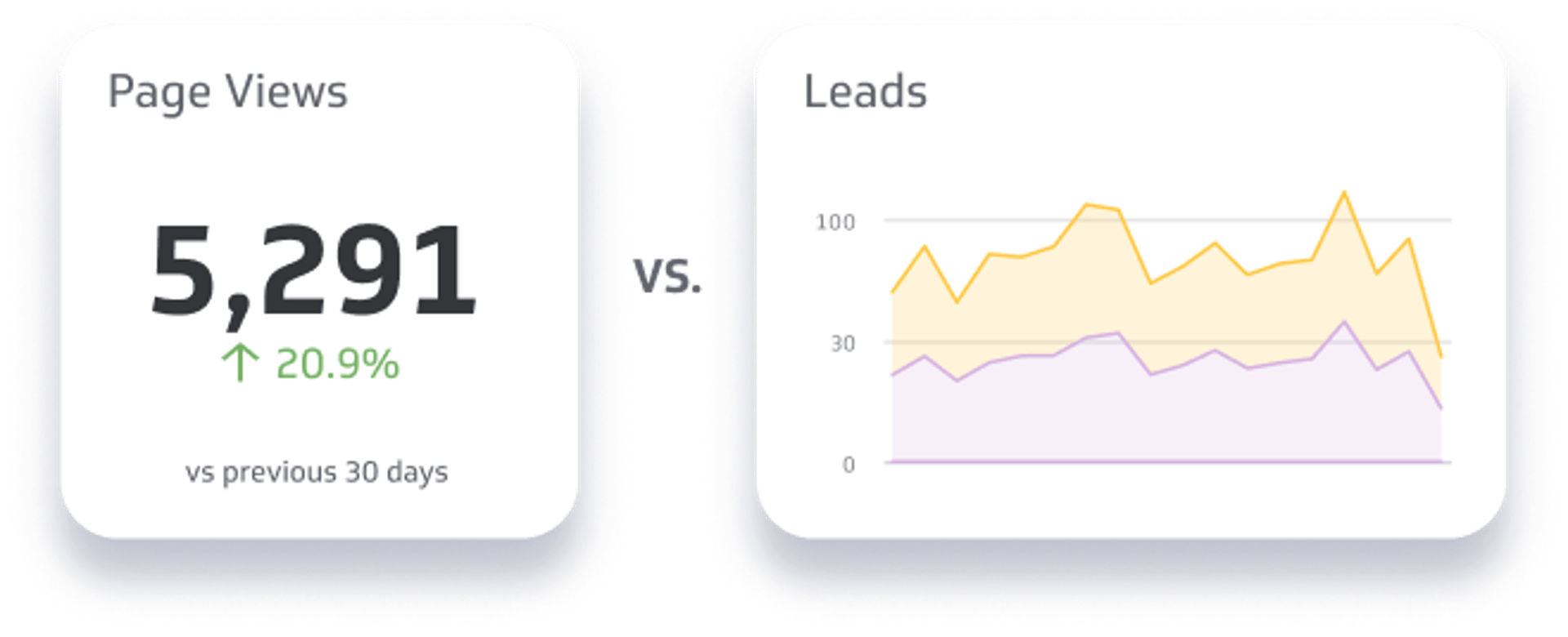Business metrics vs KPIs. What’s the difference?

Published 2023-09-19
Summary - What's the difference between a business metric and a KPI? Knowing the difference will help you understand the impact & level up your reporting.
I’d be willing to guess that most of us learning about key performance indicators (KPIs) and business metrics aren’t data scientists or business analysis. We’re curious people who want to take accountability for our performance—whether it’s in our jobs or in our personal lives. But what does learning about KPIs and metrics really mean?
Well, it means monitoring our progress while understanding how we impact it.
However, it’s also important to know the difference between a metric and a KPI.
When it comes to learning about business metrics and KPIs, you’ll discover that each term should be treated differently. It’s not just semantics, either. Using the term metric and KPI interchangeably can have an impact on how you design and implement your strategy. Taking the time to separate your metrics from your KPIs will help give you a step up on those who don't know the difference.
What’s the difference between a metric and KPI?
The difference is that KPIs are laser-focused on targets and objectives. By comparison, metrics are anything that measure processes. KPIs and metrics are not mutually exclusive. KPIs require more thought around targets, whereas metrics can exist without a target.
“In its simplest form, a KPI is a type of performance measurement that helps you understand how your organization or department is performing,” writes Ted Jackson, the founder of ClearPoint Strategy. “A good KPI should act as a compass, helping you and your team understand whether you’re taking the right path toward your strategic goals.”
Here’s an easy way to remember the difference: KPIs must have targets, a specific timeframe for reaching the target, and be relevant to business outcomes. Metrics may or may not have all of the above.
Let’s dive into the differences.

Metric vs. KPI Example
A marketing metric we track is Page Views. It’s a useful metric to measure the views of, say, a landing page associated with a specific marketing campaign. But is this a marketing KPI?
No. While it may have business value and be tied to outcomes, it’s not a direct line to achieving a business objective. Instead, we track organic search leads and wins as part of our inbound KPI strategy. This maps directly to a specific business outcome: increased revenue.
Why does it matter?
It all comes down to motivation. KPIs act like a performance guidepost and map to business outcomes.
On the other hand, metrics should be tracked at a regular cadence—like daily or weekly—because they map to your department or project performance. The caveat: If a metric is providing better business outcomes, consider adopting it as a KPI.
The process of business performance management is iterative. Don’t be afraid to experiment and try new things. Metrics can become a KPI if it impacts business outcomes. KPIs can become metrics if a target doesn’t pan into tangible results.
Every KPI is a metric, but not every metric is a KPI
For the sake of analogy, let’s pretend metrics are the individual players that make up a hockey team, but the goalie is your KPI. Every person on the team is a player, including the goalie, and each player has a specific role.
There are metrics that make up the team: customer acquisition cost, clicks, or goal conversions. These are the metrics that support your KPIs.
But your goalie, that’s your KPI. KPIs are the most important metrics you have—the ones that really underscore what your key business goals are. In this hockey analogy, it’s blocking the opposing team from scoring on your net. And you can’t win without an all-star roster of metrics (or players) to support your KPI and help you get there.
Practical examples of Metrics vs. KPIs in various industries
To understand the role of KPIs and metrics in every business, let’s continue to explore how metrics and KPIs differ in various industries:
Retail
In the retail industry, a basic metric could be the raw count of items sold daily or the number of footfalls in the store each day. These metrics simply provide data without tying directly to overall business goals.
In contrast, a retail KPI could be “Total Sales Revenue,” which is a direct reflection of a store's profitability. Another could be “Average Customer Transaction Value” to measure the average spending of a consumer per visit. This could indicate the effectiveness of sales strategies and product positioning.
Moreover, a significant KPI for retail might be the “Sales Conversion Rate.” This refers to the percentage of visitors to the store who make a purchase. This clearly links to the business goal of improving conversion for increased revenue.
Healthcare
In health care, a metric might be the number of patients seen in a day or the time between patient check-in and receiving treatment. This is called "Patient Throughput Time."
We consider this a metric because it gives an indication of hospital efficiency but isn't directly tied to the strategic organizational goals.
A healthcare KPI, however, could be “Patient Satisfaction Scores.” This is determined through exit surveys and directly impacts the quality of care provided.
Another key KPI may be “Rate of Hospital Readmission,” which measures how often patients return to the hospital for the same condition within a set period. Both these KPIs can influence funding, reputation, and overall healthcare effectiveness.
Manufacturing
In manufacturing, a metric could simply be the number of items produced on a given day. This helps measure the basic operational efficiency of the production line, providing a quick snapshot of production capacity and output. It's concrete data, but it doesn't directly tie into a broader strategic business goal.
On the other hand, a potential KPI for a manufacturing company might be "Defect Rate," which tracks the proportion of units produced that fall below the company's quality standards. This KPI is intrinsically tied to a business's broader objective of maximizing product quality to build customer satisfaction and brand reputation.
Another critical KPI in manufacturing might be "On-Time Delivery Rate." This KPI measures the percentage of products delivered to customers within the promised timeframe, which is important for customer satisfaction and supply chain efficiency. This directly aligns with a company's objectives of timely delivery and customer service and can significantly impact profitability and customer retention rates.
IT Industry
In the IT industry, ticket response time is a common metric used to track efficiency. This gives an idea of how quickly IT support staff are responding to issues. Again, it only measures a specific aspect of the service and does not necessarily align with broader strategic goals.
A potential IT KPI could be "System Uptime," which represents the amount of time that the IT systems are available and operational. This KPI is directly related to ensuring high system availability for users.
Another valuable IT KPI is "First Call Resolution Rate." This measures the percentage of support tickets that are resolved on the first interaction, indicating effectiveness and efficiency of IT support. This metric directly links to customer satisfaction and operational efficiency, two key strategic objectives for many IT organizations.
So, while metrics offer valuable insights into specific aspects of operations, KPIs are the key indicators that help you measure how well your business or department is achieving its objectives.
Remember, a KPI is essentially a metric, but not all metrics can be considered KPIs. KPIs must be directly tied to a strategic business goal, have a designated target and timeframe, and be measurable and actionable.
Separating out the KPIs from the metrics
When you measure everything, it can easily get overwhelming.
It comes down to prioritizing what’s important to you and your business. Anything, as long as you can count it, can be a metric. But what good is that if it doesn’t provide you with any insight on how your business is performing, help allocate resources, or identify strategic goals?
It’s also worth noting that while you can effectively track a multitude of metrics, KPIs lose their meaning if you have too many.
KPIs and strategy
KPIs are strategic. Identifying your KPIs forces you to sit down and think about your long-term objectives. If you’re using the wrong metric as a measuring stick, you’re going to end up wasting your time, money, and energy chasing a goal that doesn’t matter.
KPIs force you to sit down and ask, “OK, what are we actually trying to accomplish here? What are the metrics that really contribute to the success or failure of this business?”
KPIs “are metrics (Indicators) that are directly aligned with your business goals (Key), and measure how successful (Performance) you are at achieving your objectives,” writes Dave Gerhardt, the Director of Business Development and Communications for Arbill Industries.
“Your KPIs answer the questions generated by your business objective,” he adds.
How to Set Effective KPIs
Setting effective KPIs requires a deep understanding of your business objectives and what drives them. Follow these steps to ensure that your KPIs are geared towards success:
Identify your strategic business objectives
This may include increasing revenue, improving customer satisfaction, or enhancing operational efficiency. Be clear about what your business is trying to achieve so you can align your KPIs appropriately.
Understand the drivers for each objective
If your goal is to increase revenue, factors might include the number of new customers acquired, the average size of transactions, or the frequency of repeat purchases. This way, you can clearly identify which metrics are most connected to your objective and, thus, should be considered as potential KPIs.
Set specific and measurable KPIs
Once you've identified your strategic business objectives and the drivers, the next step is to set specific and measurable KPIs. For instance, if your objective is to increase customer satisfaction, your KPI could be the percentage of customer complaints resolved within 24 hours.
The KPIs should be realistic but challenging. Moreover, it should represent the level of performance you aim to achieve.
Establish a time-frame
KPIs should have a specific time frame. It could be a quarterly goal, a yearly goal, or any other period that is relevant to your objective. This will help you track progress and adjust strategies as necessary.
Monitor the KPIs regularly
This means regular review of performance against the targets set. If the targets are consistently not being met, it might be time to revise your business strategy or the KPIs themselves.
Communicate the KPIs and their importance
Additionally, everyone in the organization should understand what the KPIs are, what they mean, and how their own work contributes to achieving them. This will help foster a culture of continuous improvement and accountability.
Review and revise KPIs as necessary
As your business evolves and changes, so too will your objectives and the KPIs you use to measure them. Keep your KPIs relevant and ensure they continue to align with your business goals.
Mistakes to Avoid When Implementing KPIs and Metrics
There are several common pitfalls to avoid when implementing KPIs and metrics in your organization:
Overcomplication
Keep your KPIs and metrics simple and easy to understand. Avoid complexity in crafting these targets, as this can create barriers for team members who need to understand and utilize them.
Clear, straightforward KPIs and metrics enable everyone in your team to grasp them easily. As such, it boosts their investment and engagement in the process. Remember that the best KPIs are often the simplest. They're easy to understand, yet powerful in indicating essential aspects of business performance.
Relevance
All KPIs and metrics should be directly linked to your business strategy and goals. If they're not, they may cause an unnecessary distraction and drain on resources. Take a step back and evaluate each of your KPIs or metrics. Ask, "Does tracking this aid us in reaching our strategic goals?" If not, it might be time to reassess.
Inaccurate or irrelevant data
Ensure that the data you're using to track your KPIs and metrics is accurate, reliable, and relevant. Inaccurate data can lead to incorrect conclusions and misguided decisions.
Validate data sources regularly and ensure up-to-date data is used for your tracking. Remember, quality trumps quantity when it comes to data. It's better to have fewer data points with high accuracy than a plethora of inaccurate or less relevant ones.
Measuring too many things
Trying to measure everything can lead to data overload, with the truly important metrics becoming lost in the noise. Stay focused on a select number of KPIs that provide meaningful insight into the performance of your business.
Each KPI and metric you track should enable you to monitor progress toward your key objectives and inform strategic decision-making. It should also help discern patterns or trends that can drive your business forward.
Lacking clear objective
If your KPIs are not attached to clear objectives, their usefulness is significantly reduced. Make sure every KPI has a clear reason for why it's being tracked.
This not only provides a definitive purpose for tracking each KPI but also helps your team understand its importance. This way, it contributes to a more goal-driven culture.
Consider why you’re measuring a particular target. If you can't answer this question clearly, it might be an indication that the KPI is not sufficiently aligned with your business goals.
Ignoring qualitative measures
While quantitative data is critical for measuring performance, ignoring qualitative measures can lead to an incomplete picture. Qualitative data, such as customer satisfaction ratings or employee feedback, provides valuable context to your business. It also offers additional insights that can inform your strategies and decision-making.
Remember, it's not just about numbers. The human element matters enormously in the overall performance of your business. This includes the opinions, experiences, and perceptions of your customers. As such, combining both quantitative and qualitative measures can deliver a more holistic view of your business performance.
Inflexibility
Being rigid about your KPIs and refusing to adapt them over time can lead to problems. The business environment is constantly changing, and your KPIs need to reflect these changes. Be open to adjusting and redefining your KPIs if they're no longer effective or relevant.
Review and reassess your KPIs to drive continuous improvement and innovation. Ignoring the need to adapt to business trends can result in a lack of agility. As such, this can impede your business's growth and competitive advantage.
Treating all KPIs equally
Not all KPIs are of equal importance, and they shouldn’t be treated as such. Identify and focus more on your critical success factors. These are the few key areas where things must go right for your business to flourish.
Maintaining a hierarchy of KPIs helps in aligning and prioritizing your focus areas. Set primary metrics directly influencing your bottom-line performance as a top priority to ensure a clearer focus on company-wide strategic goals.
Failure to communicate KPIs effectively
Poor communication means that team members won’t understand what they're aiming for. This can lead to confusion, misalignment, and a lack of ownership.
Be sure to clearly communicate the what, why, and how of each KPI to everyone involved. This understanding will promote a sense of purpose and guide teams in making decisions that contribute towards achieving the KPIs.
Remember, effective communication of KPIs also involves creating a feedback loop. This is where insights gathered are shared and discussed. Having this space for dialogue cultivates a transparent environment where everyone is aware of the progress and any potential issues.
Ignoring external factors
While it's crucial to focus on your business's internal metrics, don't ignore the impacts of external factors. These can all influence your KPIs and metrics, including:
- Market trends
- Economic indicators
- Competitive activities
Be mindful of these factors when analyzing your data and making strategic decisions. Building awareness also helps in your team’s comprehensive performance evaluation. It encourages a broader perspective in understanding your business operations, positioning, and the marketplace.
Bringing it all together
The difference between metrics and KPIs often goes unnoticed in a world where nearly everything can be and is measured. Staking out a ring around those metrics that can actually give you a strategic sense for how your business is performing is more than worth the time. Learn how business leaders are using KPIs and metrics to build businesses that succeed with data on the Metric Stack podcast.
This article was originally published in October 2017 and has been revamped and updated for accuracy.
Related Articles

Promoting data literacy with metrichq.org and the power of AI
By Allan Wille, Co-Founder — October 12th, 2023
Let’s fix analytics so we can stop asking you for dashboards
By Cathrin Schneider — September 11th, 2023
Why metrics are the key to confident decision making
By Graham Watts — July 31st, 2023

